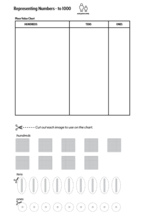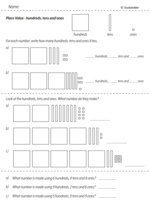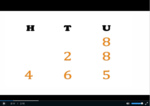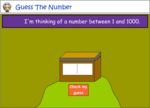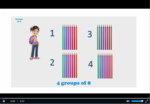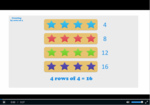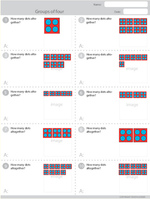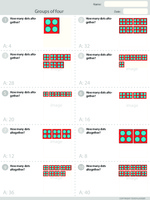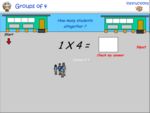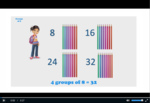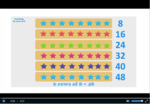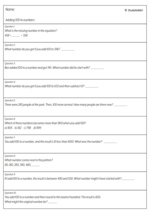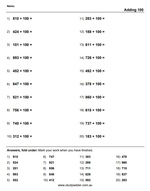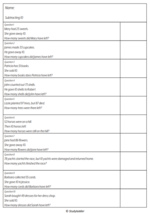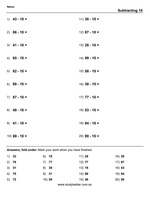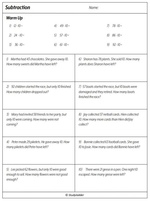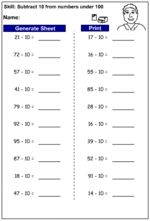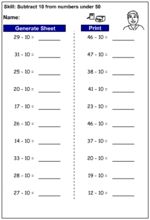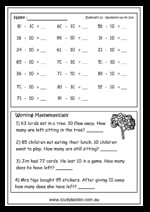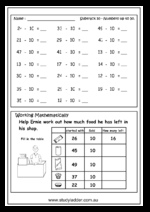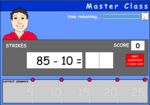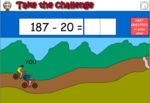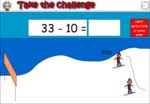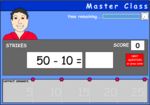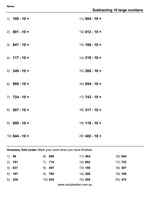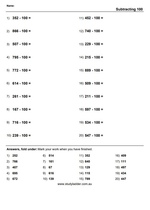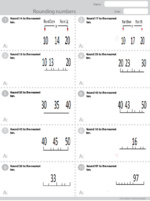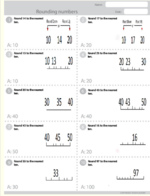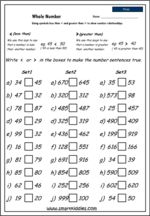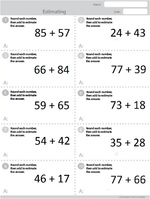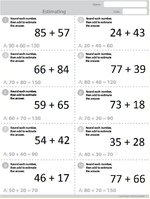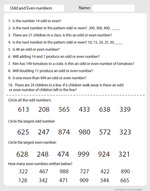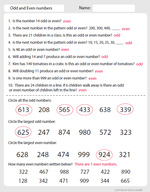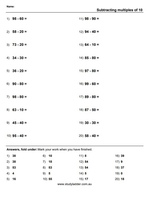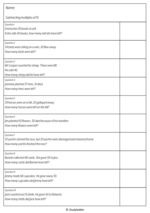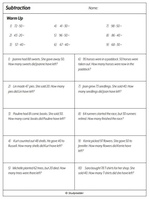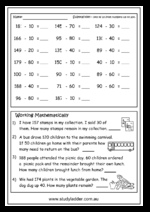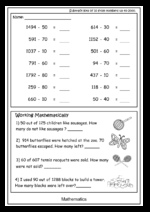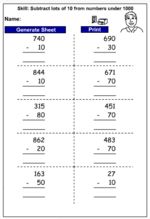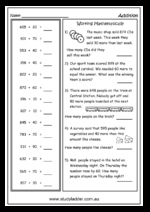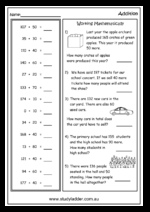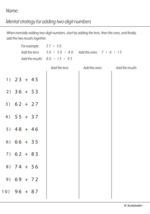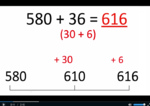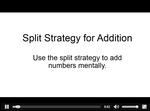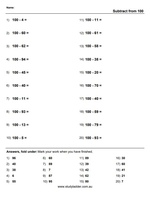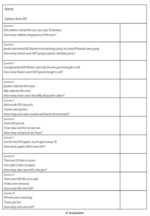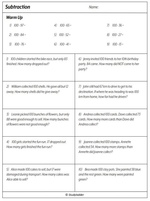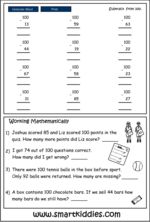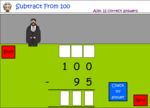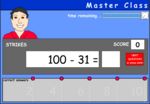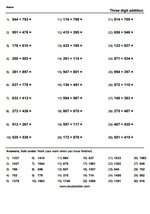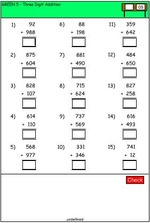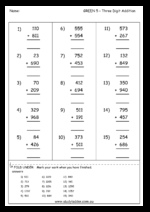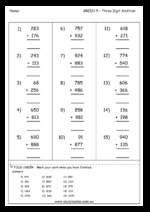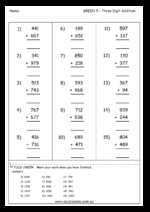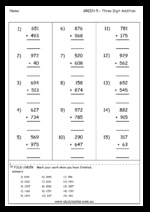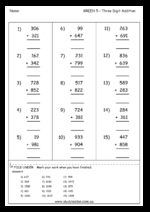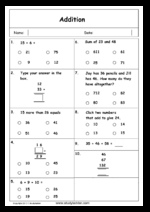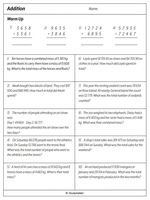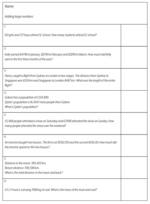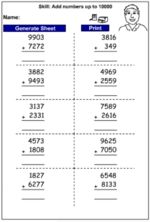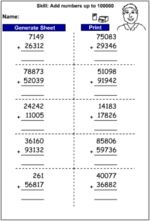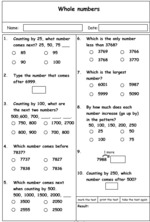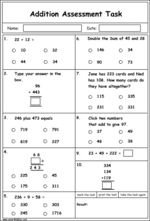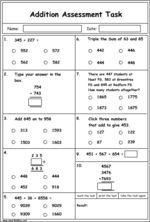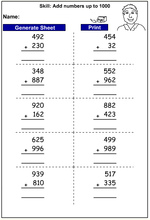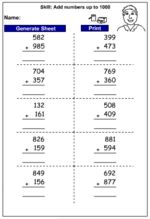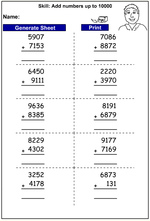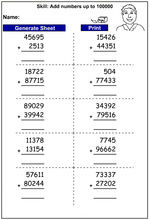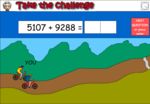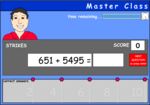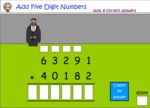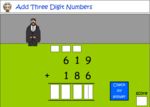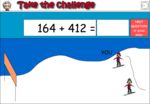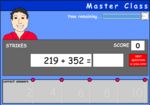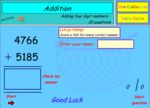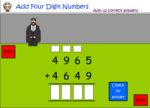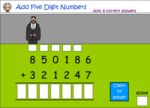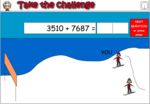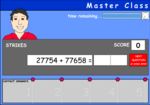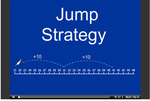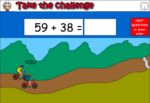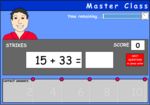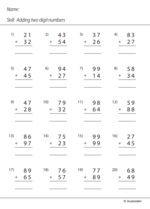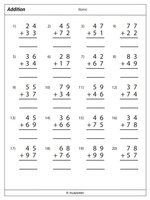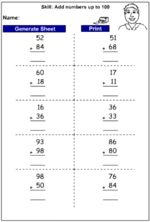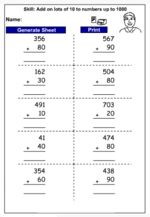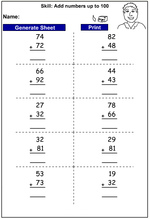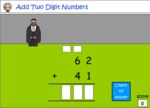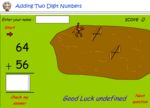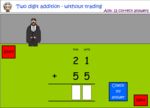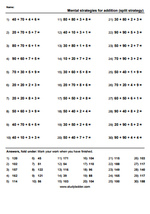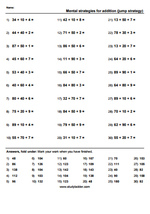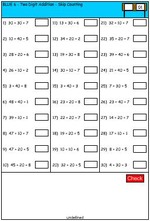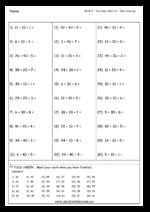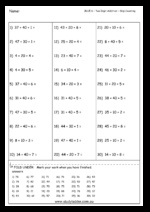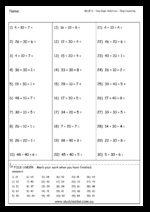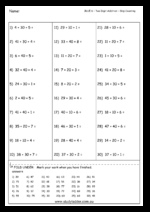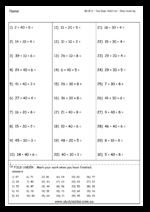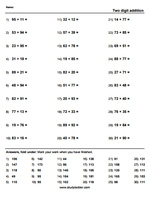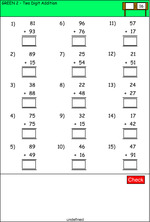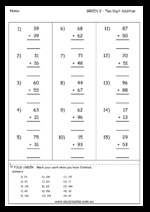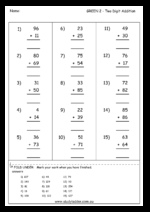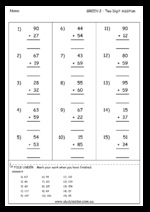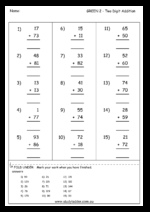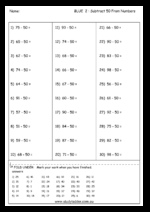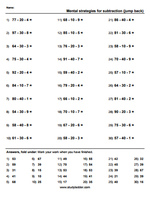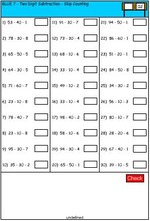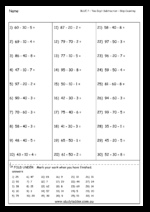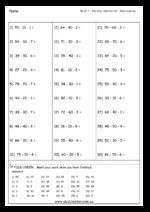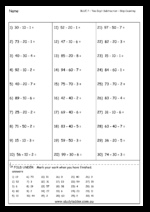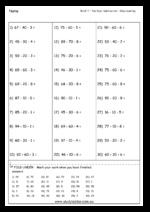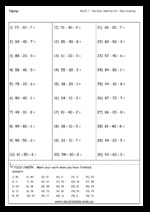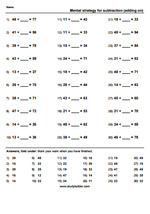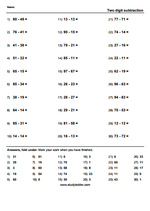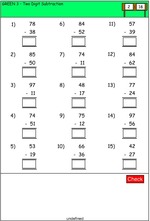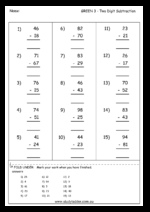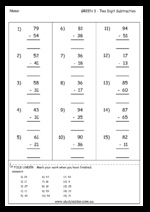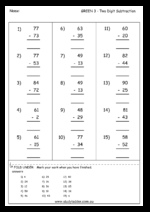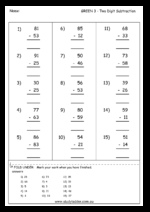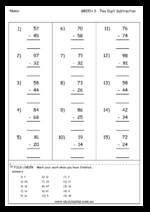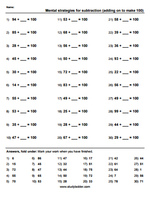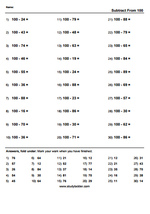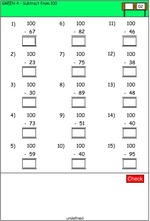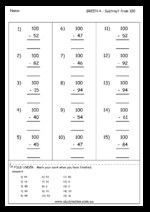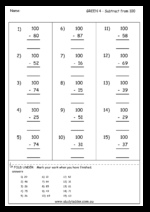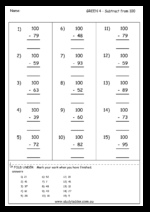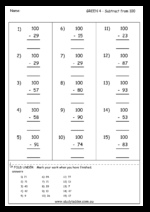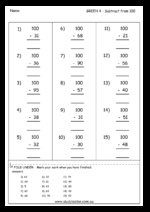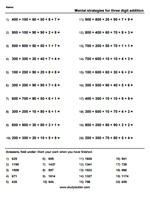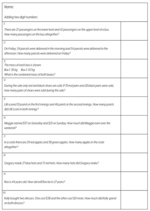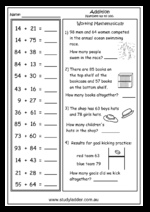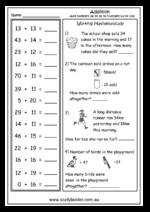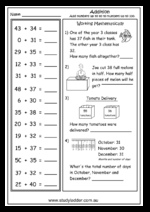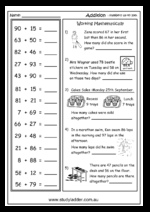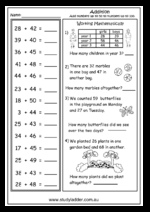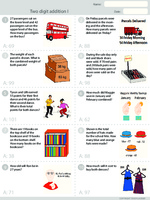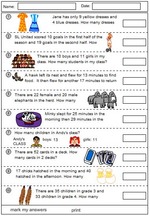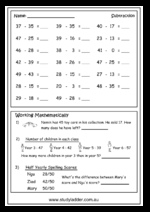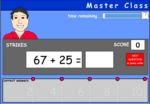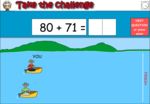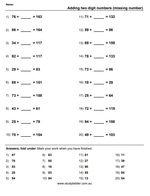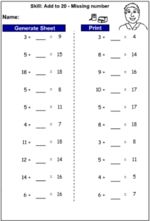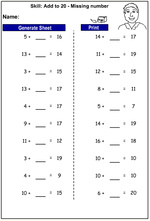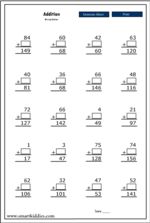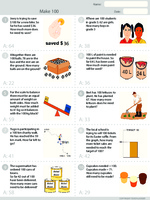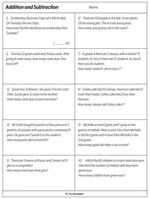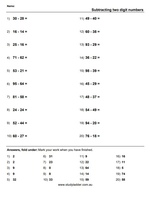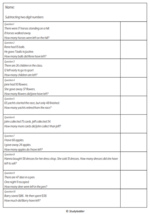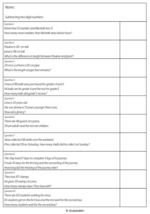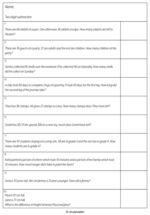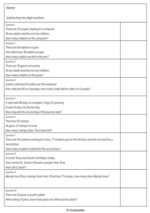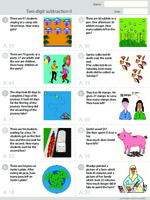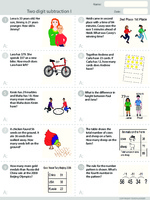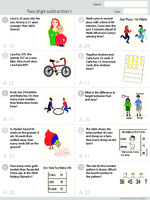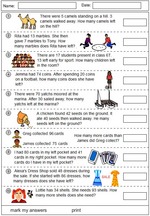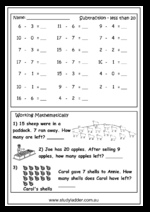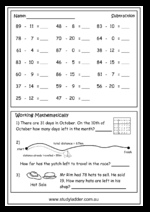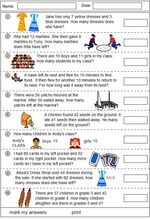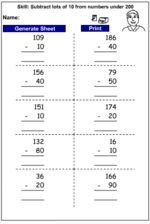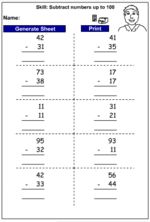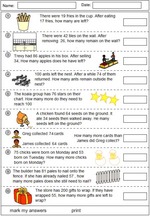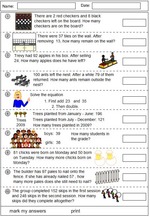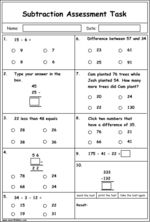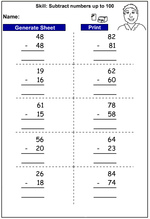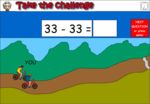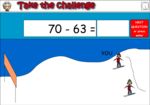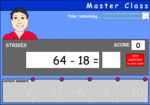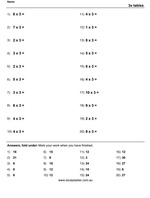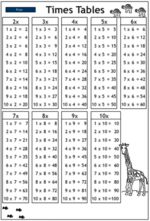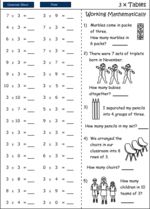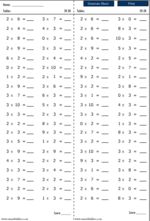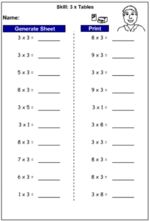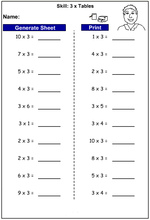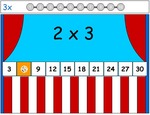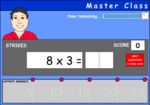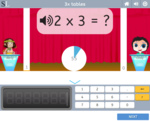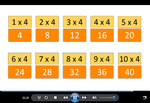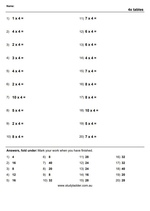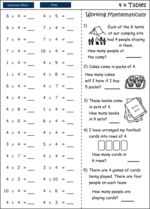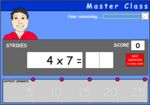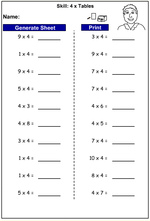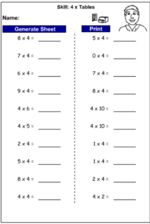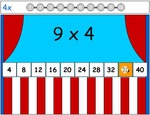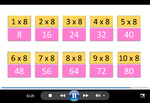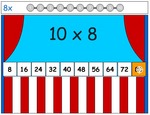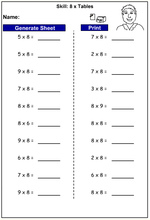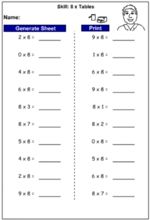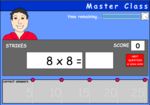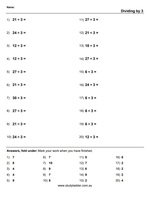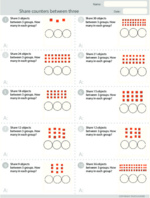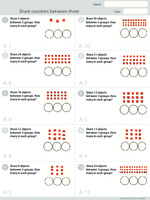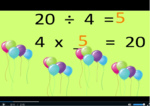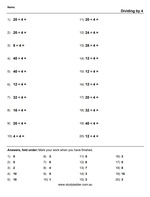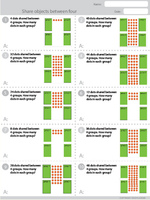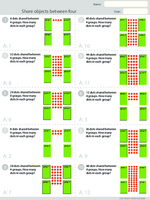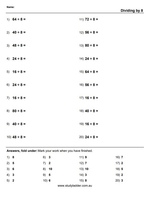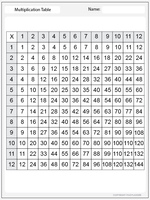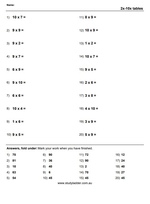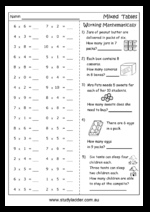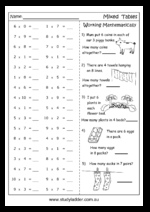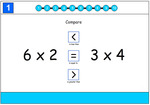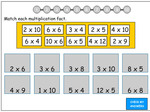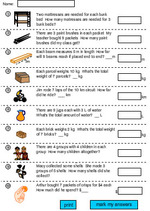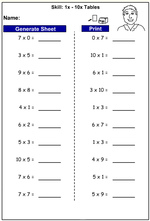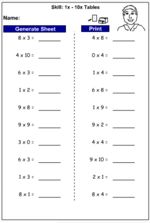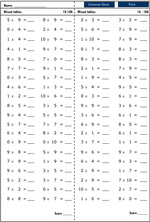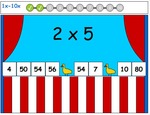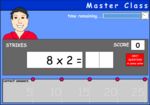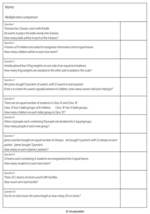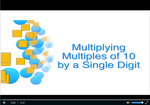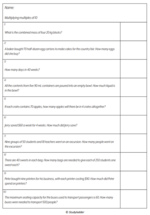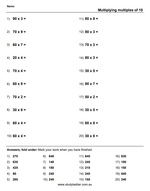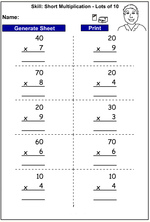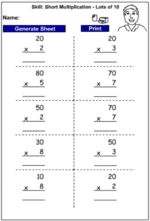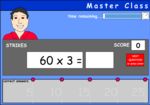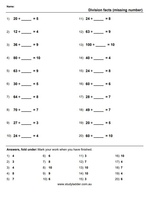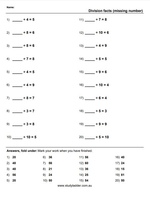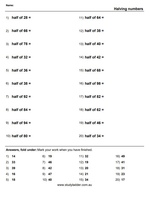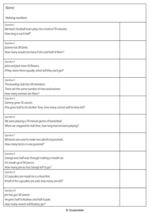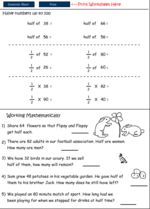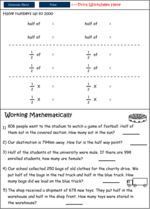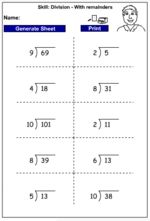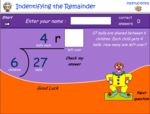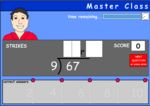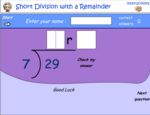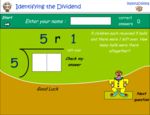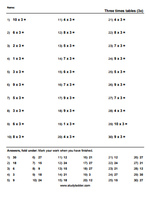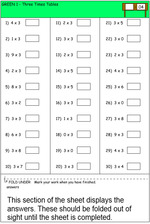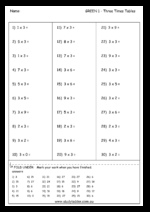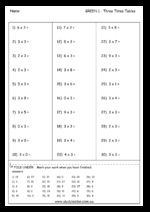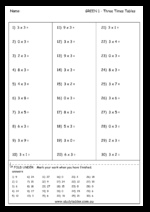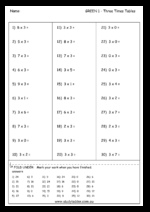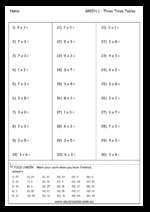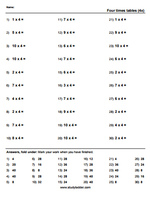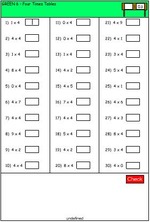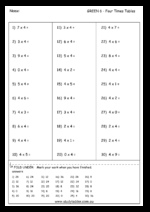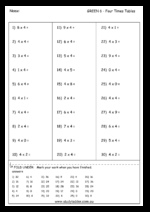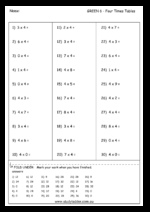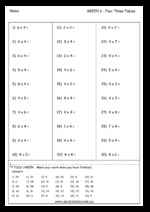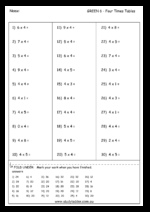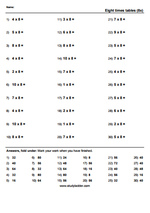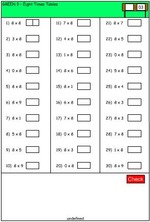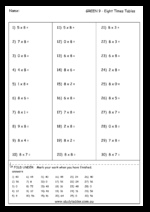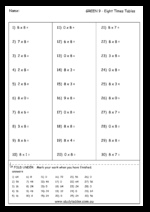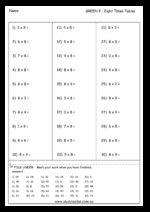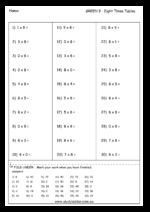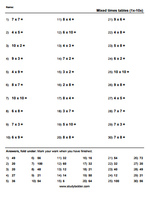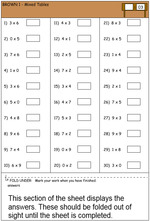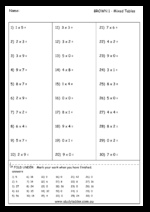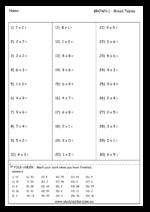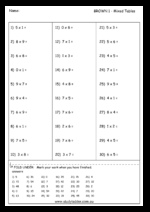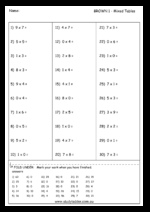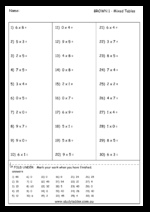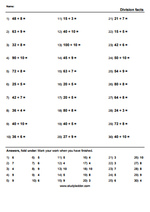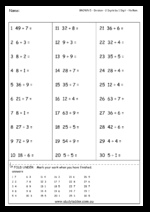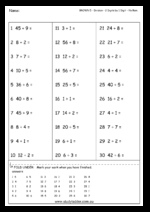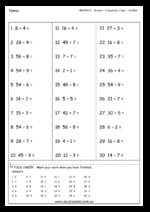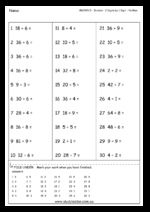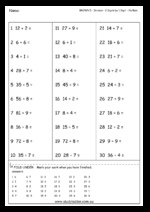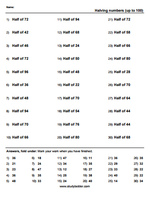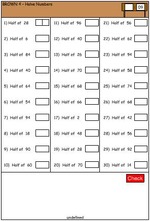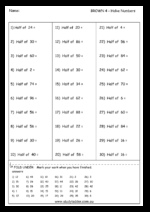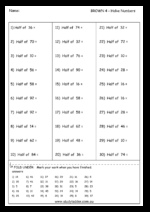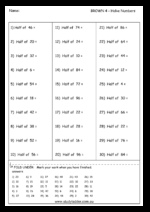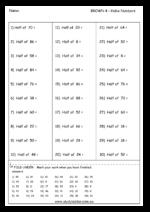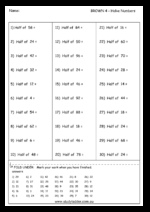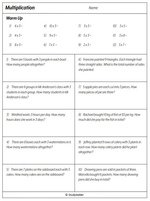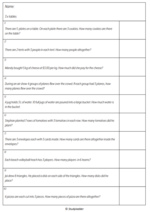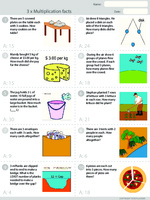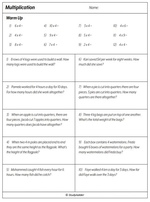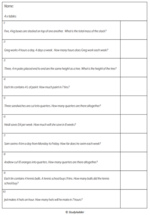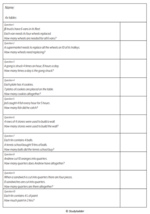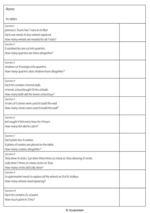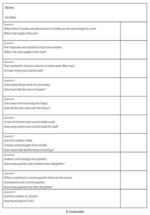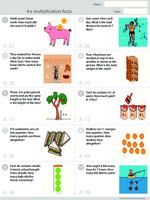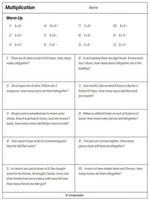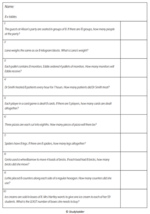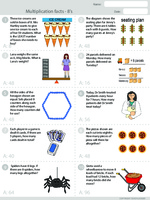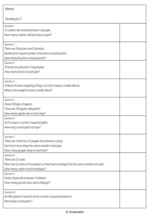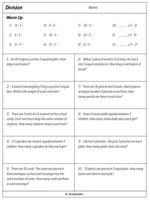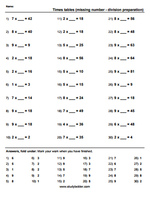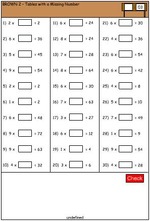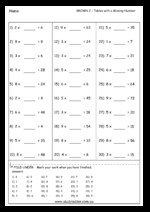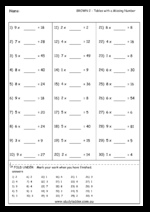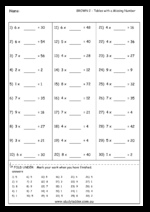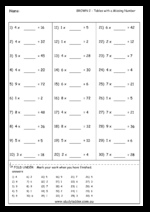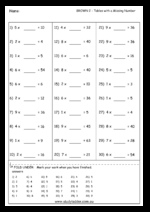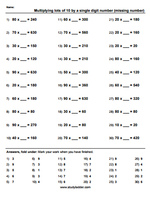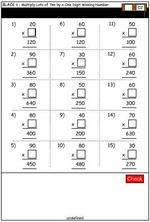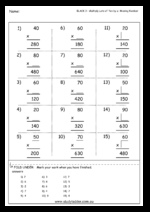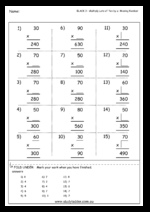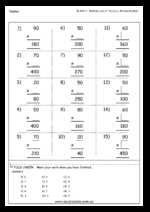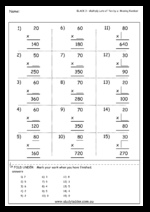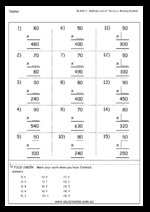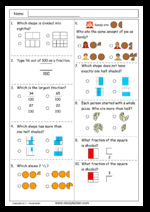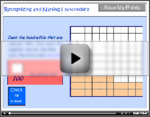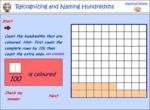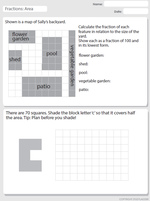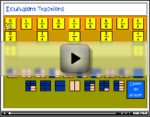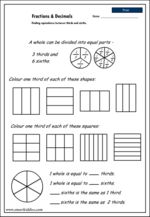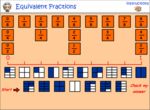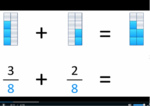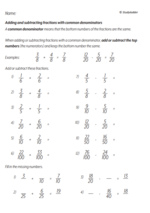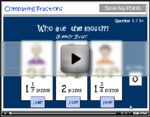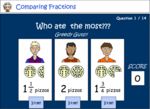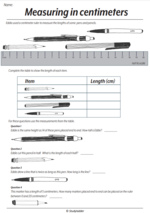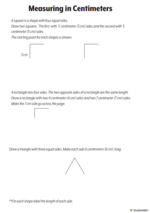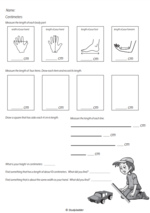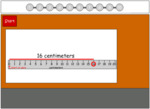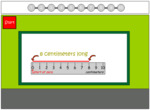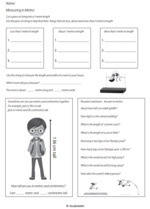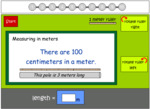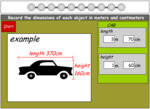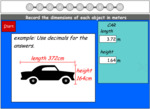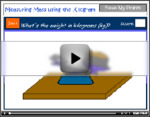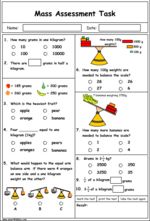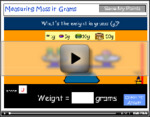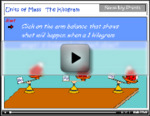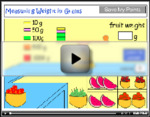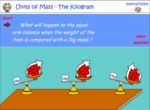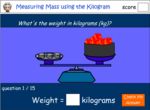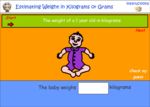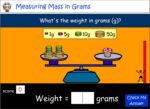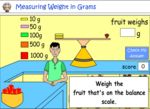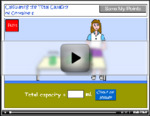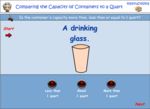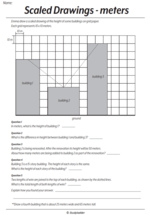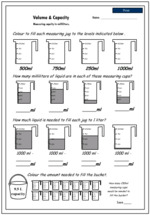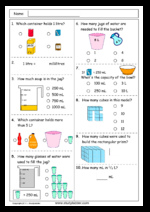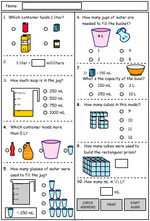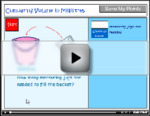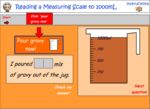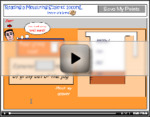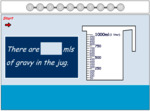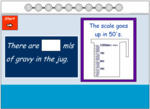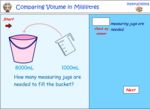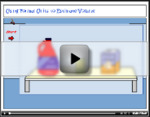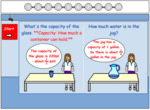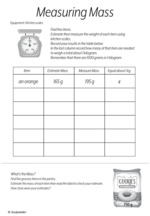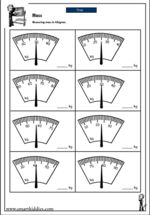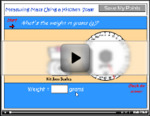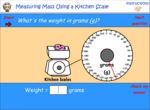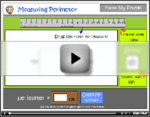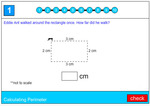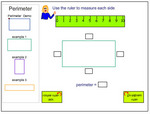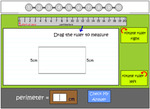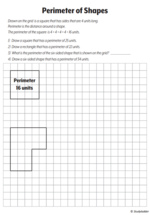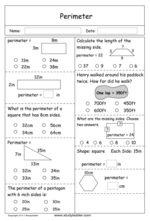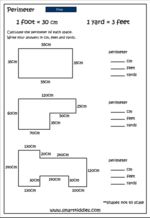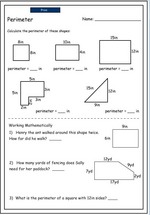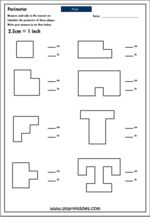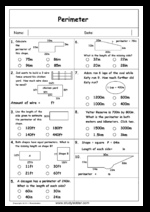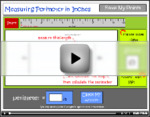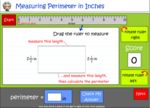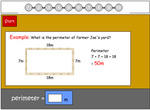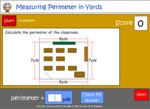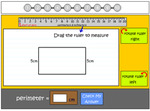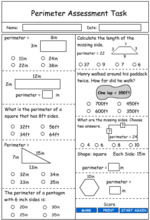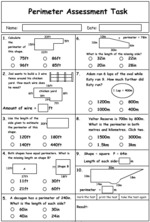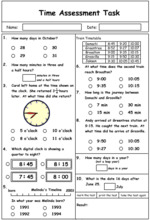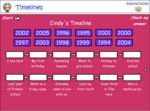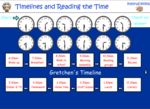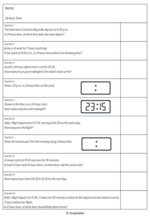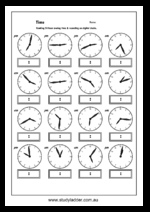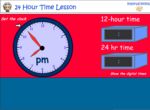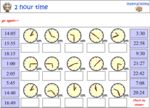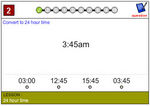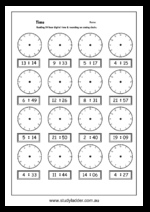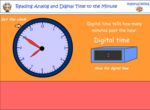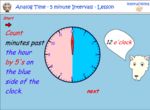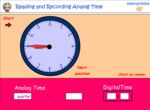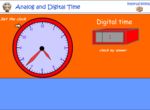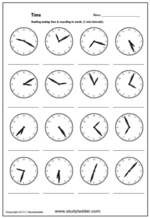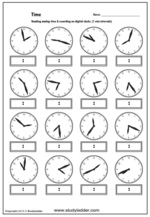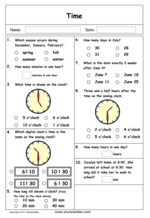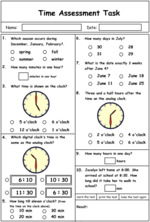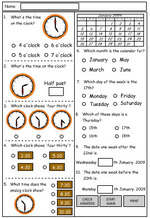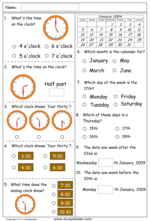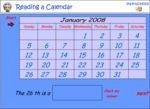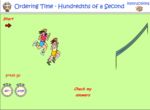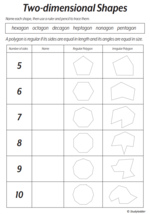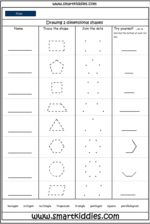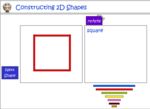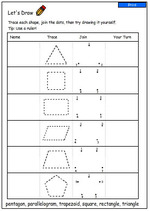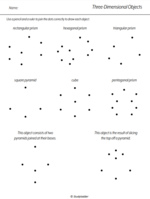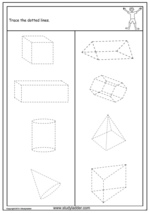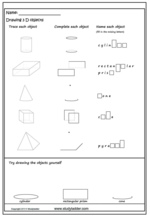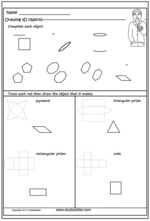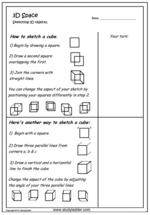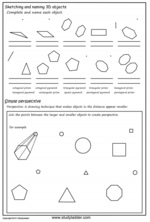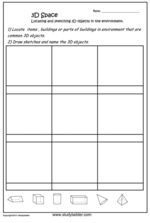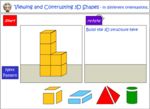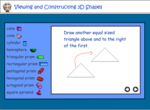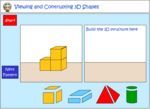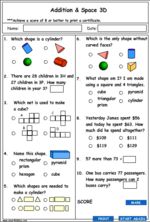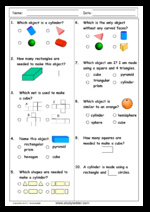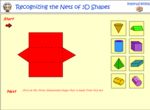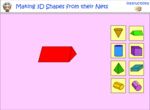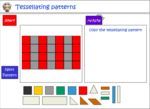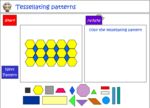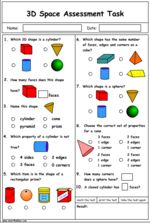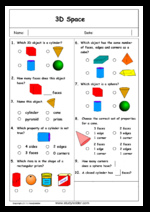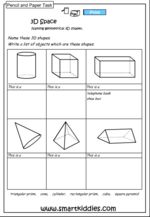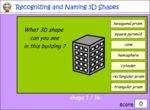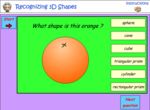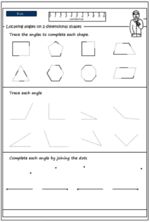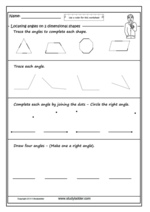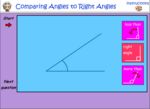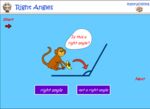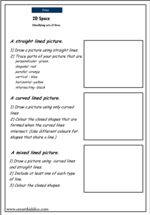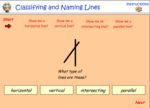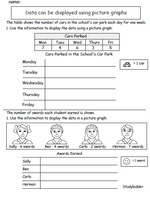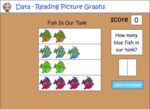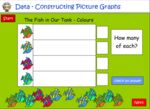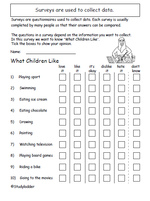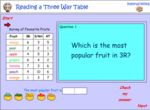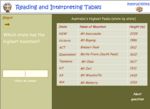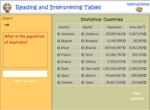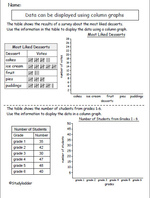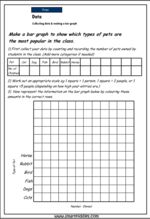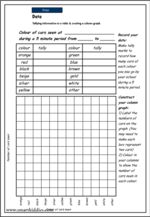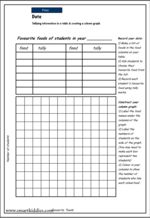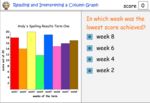Mathematics – United Kingdom – National Curriculum
Year 3 programme of study
KS2.Y3.N.NPV – Number - number and place value
Pupils should be taught to:
KS2.Y3.N.NPV.1 – Count from 0 in multiples of 4, 8, 50 and 100; find 10 or 100 more or less than a given number
-
8 learning outcomes – click to view
Samples: Place value - hundreds, tens and ones. Groups of 4. Groups of 8. Adding 100. Subtracting 10.
-
Place value - hundreds, tens and ones (to 999)
- Activities: 4 course, 3 extra
-
-
- Place Value
- Tutorial
-
Extra activities
-
Groups and rows of 4
- Activities: 3 course, 4 extra
-
-
- Groups of 4
- Tutorial
-
-
-
- Rows of 4
- Tutorial
-
-
-
- Groups of 4
- Practice
-
Extra activities
-
-
- Groups of 4
- Tutorial
-
-
-
- Groups of four
- Printable
-
-
-
- Groups of four Answer sheet
- Printable
-
-
-

- Groups of four
- Practice
-
-
Adding-on 100
- Activities: 3 course, 1 extra
-
-
- Adding 100
- Practice
-
-
-
- Adding 100 problem solving
- Practice
-
-
-
- Adding 100 problem solving
- Printable
-
Extra activities
-
-
- Adding 100
- Printable
-
-
Subtracting 10
- Activities: 7 course, 12 extra
-
-
- Subtracting 10
- Tutorial
-
-
-
- Subtract 10
- Practice
-
-
-
- Subtracting 10 (problem solving)
- Practice
-
-
-
- Subtracting 10
- Printable
-
-
-
- Subtracting 10
- Tutorial
-
-
-
- Subtracting 10
- Challenge
-
-
-
- Subtracting 10
- Practice
-
Extra activities
-
-
- Subtracting 10
- Printable
-
-
-
- Subtracting 10 (problem solving)
- Printable
-
-
-
- Subtracting 10 (problem solving)
- Printable
-
-
-
- Subtract 10 from numbers under 100
- Printable
-
-
-
- Subtract 10 from larger numbers
- Printable
-
-
-
- Subtract 10 from numbers
- Printable
-
-
-

- Subtract 10 from larger numbers
- Assessment
-
-
-

- Subtract 10 from larger numbers
- Challenge
-
-
-

- Subtract 10 from numbers
- Assessment
-
-
Subtracting 10 from larger numbers
- Activities: 1 course, 1 extra
-
Subtracting 100 from larger numbers
- Activities: 1 course, 1 extra
-
Rounding to the nearest 10
- Activities: 3 course, 3 extra
-
-
- Rounding numbers: Activity 2
- Practice
-
-
-
- Rounding numbers: Activity 4
- Practice
-
Extra activities
-
-
- Rounding numbers
- Printable
-
-
-
- Rounding numbers Answer sheet
- Printable
-
-
-
8 learning outcomes – click to view
KS2.Y3.N.NPV.2 – Recognise the place value of each digit in a 3-digit number (100s, 10s, 1s)
-
1 learning outcomes – click to view
Samples: Place value - hundreds, tens and ones. Place value - hundreds, tens and ones.
-
Place value - hundreds, tens and ones (to 999)
- Activities: 4 course, 3 extra
-
-
- Place Value
- Tutorial
-
Extra activities
-
-
1 learning outcomes – click to view
KS2.Y3.N.NPV.3 – Compare and order numbers up to 1,000
-
2 learning outcomes – click to view
Samples: Comparing numbers to 1000 (< = >). Comparing numbers to 10,000 (<,=,>). Greater than or less than.
-
Comparing numbers to 1000 (< = >)
- Activities: 2 course, 1 extra
-
-
- Comparing numbers to 1000 (< = >)
- Practice
-
-
-
- Comparing numbers to 10,000 (<,=,>)
- Practice
-
Extra activities
-
-
- Greater than or less than
- Printable
-
-
-
2 learning outcomes – click to view
KS2.Y3.N.NPV.4 – Identify, represent and estimate numbers using different representations
-
1 learning outcomes – click to view
Samples: Adding two digit numbers (estimating). Estimating. Estimating Answer sheet.
-
Adding two-digit numbers by rounding then estimating
- Activities: 1 course, 2 extra
Extra activities
-
-
- Estimating
- Printable
-
-
-
- Estimating Answer sheet
- Printable
-
-
-
1 learning outcomes – click to view
KS2.Y3.N.NPV.5 – Read and write numbers up to 1,000 in numerals and in words
KS2.Y3.N.NPV.6 – Solve number problems and practical problems involving these ideas
-
4 learning outcomes – click to view
Samples: Challenge puzzle. Comparing and Counting Money - Notes and Coins. Odd numbers. Rounding to the nearest hundred.
-
Comparing and counting notes and coins
- Activities: 1 course, 0 extra
-
Odd and even numbers
- Activities: 3 course, 2 extra
-
-
- Odd numbers
- Practice
-
-
-
- Even numbers
- Practice
-
-
-
- Even or odd
- Practice
-
Extra activities
-
-
- Even or Odd numbers
- Printable
-
-
-
- Even or Odd numbers Answer sheet
- Printable
-
-
Rounding to the nearest hundred
- Activities: 3 course, 0 extra
-
-
- Rounding to the nearest hundred
- Practice
-
-
-
- Rounding to the nearest hundred
- Practice
-
-
4 learning outcomes – click to view
KS2.Y3.N.AS – Number - addition and subtraction
Pupils should be taught to:
KS2.Y3.N.AS.1 – Add and subtract numbers mentally, including:
KS2.Y3.N.AS.1.a: a three-digit number and 1s
KS2.Y3.N.AS.1.b: a three-digit number and 10s
-
4 learning outcomes – click to view
Samples: Subtracting multiples of 10. Adding multiples of 10. Adding two digit numbers (split strategy).
-
Subtracting multiples of 10
- Activities: 4 course, 7 extra
-
-
- Subtracting multiples of 10
- Tutorial
-
-
-
- Subtracting multiples of 10
- Practice
-
-
-
- Subtracting multiples of 10
- Tutorial
-
Extra activities
-
-
- Subtracting multiples of 10
- Printable
-
-
-
- Subtracting multiples of 10
- Printable
-
-
-
- Subtracting multiples of 10
- Printable
-
-
-
- Subtract Multiples Of 10
- Tutorial
-
-
Adding multiples of 10
- Activities: 1 course, 3 extra
-
Adding two-digit numbers using the split strategy
- Activities: 6 course, 2 extra
-
Subtracting from 100
- Activities: 6 course, 7 extra
-
-
- Subtracting from 100
- Tutorial
-
-
-
- Subtracting from 100
- Practice
-
-
-
- Subtracting from 100
- Challenge
-
-
-
- Subtracting from 100
- Tutorial
-
-
-
- Subtracting from 100
- Tutorial
-
Extra activities
-
-
- Subtracting from 100
- Printable
-
-
-
- Subtract from 100
- Printable
-
-
-
- Subtracting from 100
- Printable
-
-
-
- Subtracting from 100
- Printable
-
-
-
- Subtract from 100 - Written Strategy
- Tutorial
-
-
-

- Subtract from 100
- Practice
-
-
-

- Subtract from 100
- Assessment
-
-
-
4 learning outcomes – click to view
KS2.Y3.N.AS.1.c: a three-digit number and 100s
-
3 learning outcomes – click to view
Samples: Adding three digit numbers using blocks. Place value - subtracting three-digit numbers.
-
Place value - adding three-digit numbers
- Activities: 2 course, 0 extra
-
Place value - subtracting three-digit numbers
- Activities: 1 course, 0 extra
-
Three digit addition (Skill 48)
- Activities: 6 course, 7 extra
-
-
- Adding three-digit numbers
- Tutorial
-
-
-
- Addition of three digit numbers
- Tutorial
-
-
-
- Three digit addition
- Practice
-
-
-
- Three digit addition
- Practice
-
-
-
- Three digit addition
- Practice
-
-
-
- Three digit addition
- Assessment Practice
-
Extra activities
-
-
- Three digit addition
- Printable
-
-
-

- Three Digit Addition Vertical
- Printable
-
-
-
- green 5 sheet 1
- Printable
-
-
-
- green 5 sheet 2
- Printable
-
-
-
- green 5 sheet 3
- Printable
-
-
-
- green 5 sheet 4
- Printable
-
-
-
- green 5 sheet 5
- Printable
-
-
-
3 learning outcomes – click to view
KS2.Y3.N.AS.2 – Add and subtract numbers with up to 3 digits, using formal written methods of columnar addition and subtraction
-
5 learning outcomes – click to view
Samples: Addition of large numbers. Subtracting three digit numbers. Adding two digit numbers (split strategy).
-
Adding large numbers
- Activities: 5 course, 29 extra
-
-
- Addition of large numbers
- Practice
-
-
-
- Adding five digit numbers
- Tutorial
-
-
-
- Adding large numbers
- Tutorial
-
-
-
- Addition Problem Solving
- Printable
-
Extra activities
-
-
- Adding large numbers (problem solving)
- Printable
-
-
-
- Adding large numbers (problem solving)
- Printable
-
-
-
- Addition Of Three Digit Numbers
- Tutorial
-
-
-
- Addition Of Four Digit Numbers
- Tutorial
-
-
-
- Addition of five digit numbers
- Tutorial
-
-
-
- Addition of large numbers
- Tutorial
-
-
-

- Numbers Problem Solving
- Assessment
-
-
-

- Addition Problem Solving
- Assessment
-
-
-
- Addition of three digit numbers
- Printable
-
-
-

- Addition Problem Solving
- Assessment
-
-
-

- Addition of five digit numbers
- Challenge
-
-
-

- Addition of five digit numbers
- Assessment
-
-
-

- Addition of five digit numbers
- Practice
-
-
-

- Addition of three digit numbers
- Practice
-
-
-

- Addition of three digit numbers
- Challenge
-
-
-

- Addition of three digit numbers
- Assessment
-
-
-

- Addition of four digit numbers
- Practice
-
-
-

- Addition of four digit numbers
- Practice
-
-
-

- Addition of large numbers
- Practice
-
-
-

- Addition of four digit numbers
- Challenge
-
-
-

- Addition of large numbers
- Assessment
-
-
-
- Addition of three digit numbers
- Tutorial
-
-
-
- Addition of four digit numbers
- Tutorial
-
-
Subtracting three digit numbers
- Activities: 2 course, 0 extra
-
-
- Subtracting three digit numbers
- Practice
-
-
-
- Add within 1000
- Practice
-
-
Adding two-digit numbers using the split strategy
- Activities: 6 course, 2 extra
-
Adding two-digit numbers using the jump strategy
- Activities: 6 course, 5 extra
Extra activities
-
-
- Jump Strategy/Method Explained
- Tutorial
-
-
-
- Jump Strategy/Method
- Tutorial
-
-
-

- Addition of two digit numbers
- Challenge
-
-
-

- Addition of Two Digit Numbers
- Assessment
-
-
Adding two-digit numbers using the written strategy
- Activities: 5 course, 11 extra
Extra activities
-
-

- Addition of two digit numbers
- Practice
-
-
-

- Addition of two digit numbers
- Practice
-
-
-

- Addition of two digit numbers
- Tutorial
-
-
-
5 learning outcomes – click to view
KS2.Y3.N.AS.3 – Estimate the answer to a calculation and use inverse operations to check answers
-
9 learning outcomes – click to view
Samples: Adding two digit numbers (split strategy). Adding two digit numbers (jump strategy). Two digit addition.
-
Mental strategies for addition (Skill 39)
- Activities: 5 course, 1 extra
-
-
- Mental strategies for addition (split strategy)
- Assessment Practice
-
Extra activities
-
Mental strategies for addition - jump strategy (Skill 40)
- Activities: 5 course, 7 extra
-
-
- Mental strategies for addition (jump strategy)
- Assessment Practice
-
Extra activities
-
-

- Two Digit Addition Skip Counting
- Printable
-
-
-
- blue 6 sheet 1
- Printable
-
-
-
- blue 6 sheet 2
- Printable
-
-
-
- blue 6 sheet 3
- Printable
-
-
-
- blue 6 sheet 4
- Printable
-
-
-
- blue 6 sheet 5
- Printable
-
-
Two digit addition (Skill 41)
- Activities: 4 course, 7 extra
-
-
- Two digit addition
- Practice
-
-
-
- Two digit addition
- Practice
-
-
-
- Two digit addition
- Practice
-
-
-
- Two digit addition
- Assessment Practice
-
Extra activities
-
-
- Two digit addition
- Printable
-
-
-

- Two Digit Addition Vertical
- Printable
-
-
-
- green 2 sheet 1
- Printable
-
-
-
- green 2 sheet 2
- Printable
-
-
-
- green 2 sheet 3
- Printable
-
-
-
- green 2 sheet 4
- Printable
-
-
-
- green 2 sheet 5
- Printable
-
-
Mental strategies for subtraction - jump back (Skill 42)
- Activities: 5 course, 7 extra
-
-
- Subtracting (jumping back)
- Tutorial
-
-
-
- Mental strategies for subtraction (jump back)
- Assessment Practice
-
Extra activities
-
-

- Two Digit Subtraction Jump Strategy
- Printable
-
-
-
- blue 7 sheet 1
- Printable
-
-
-
- blue 7 sheet 2
- Printable
-
-
-
- blue 7 sheet 3
- Printable
-
-
-
- blue 7 sheet 4
- Printable
-
-
-
- blue 7 sheet 5
- Printable
-
-
Mental strategy for subtraction - adding on (Skill 43)
- Activities: 5 course, 1 extra
-
-
- Mental strategy for subtraction (adding on)
- Assessment Practice
-
Extra activities
-
-
- Mental strategy for subtraction (adding on)
- Practice Printable
-
-
Two digit subtraction (Skill 44)
- Activities: 4 course, 7 extra
-
-
- Two digit subtraction
- Practice
-
-
-
- Two digit subtraction
- Practice
-
-
-
- Two digit subtraction
- Practice
-
-
-
- Two digit subtraction
- Assessment Practice
-
Extra activities
-
-
- Two digit subtraction
- Printable
-
-
-

- Two Digit Subtraction Vertical
- Printable
-
-
-
- green 3 sheet 1
- Printable
-
-
-
- green 3 sheet 2
- Printable
-
-
-
- green 3 sheet 3
- Printable
-
-
-
- green 3 sheet 4
- Printable
-
-
-
- green 3 sheet 5
- Printable
-
-
Mental strategies for subtraction - adding on to make 100 (Skill 45)
- Activities: 4 course, 1 extra
-
-
- Mental Strategy for subtraction (adding on to make 100)
- Assessment Practice
-
Extra activities
-
Subtract From 100 (Skill 46)
- Activities: 5 course, 7 extra
-
-
- Subtracting from 100
- Tutorial
-
-
-
- Subtract From 100
- Practice
-
-
-
- Subtract From 100
- Practice
-
-
-
- Subtract From 100
- Practice
-
-
-
- Subtract From 100
- Assessment Practice
-
Extra activities
-
-
- Subtract From 100
- Printable
-
-
-

- Subtract From 100
- Printable
-
-
-
- green 4 sheet 1
- Printable
-
-
-
- green 4 sheet 2
- Printable
-
-
-
- green 4 sheet 3
- Printable
-
-
-
- green 4 sheet 4
- Printable
-
-
-
- green 4 sheet 5
- Printable
-
-
Mental strategies - 3 digit addition (Skill 47)
- Activities: 5 course, 1 extra
-
-
- Mental strategies for three digit addition
- Assessment Practice
-
Extra activities
-
-
9 learning outcomes – click to view
KS2.Y3.N.AS.4 – Solve problems, including missing number problems, using number facts, place value, and more complex addition and subtraction
-
8 learning outcomes – click to view
Samples: Adding two digit numbers (problem solving). Challenge Puzzle - Addition Pyramid.
-
Adding two digit numbers - problem solving
- Activities: 6 course, 12 extra
Extra activities
-
-
- Adding two digit numbers
- Printable
-
-
-
- Adding two digit numbers
- Printable
-
-
-
- Adding two digit numbers
- Printable
-
-
-
- Adding two digit numbers
- Printable
-
-
-
- Addition of two digit numbers
- Printable
-
-
-
- Adding two digit numbers
- Printable
-
-
-

- Problem solving using addition
- Assessment
-
-
-
- Subtraction - two digit numbers
- Printable
-
-
-

- Addition of two digit numbers
- Assessment
-
-
-

- Addition using the Jump Strategy/Method
- Challenge
-
-
Challenge Puzzle - Addition Pyramid
- Activities: 1 course, 0 extra
-
-
- Challenge Puzzle - Addition Pyramid
- Practice
-
-
Make 100 - problem solving
- Activities: 0 course, 2 extra
Extra activities
-
-
- Make 100 Answer sheet
- Printable
-
-
-
- Make 100BETA
- Assessment
-
-
Subtraction (two step problem solving)
- Activities: 2 course, 1 extra
-
Subtracting two-digit numbers
- Activities: 6 course, 22 extra
-
-
- Subtracting two digit numbers
- Practice
-
Extra activities
-
-
- Subtracting two digit numbers
- Printable
-
-
-
- Subtracting two digit numbers
- Printable
-
-
-
- Subtracting two digit numbers
- Printable
-
-
-
- Subtract numbers less than 20
- Printable
-
-
-
- Drill - Subtract numbers up to 100
- Printable
-
-
-

- Problem solving using subtraction
- Assessment
-
-
-

- Subtraction
- Assessment
-
-
-

- Subtraction - two digit numbers
- Challenge
-
-
-

- Subtraction of two digit numbers
- Challenge
-
-
-

- Subtraction of two digit numbers
- Assessment
-
-
Challenge puzzle - two digit subtraction
- Activities: 1 course, 0 extra
-
-
8 learning outcomes – click to view
KS2.Y3.N.MD – Number - multiplication and division
Pupils should be taught to:
KS2.Y3.N.MD.1 – Recall and use multiplication and division facts for the 3, 4 and 8 multiplication tables
-
6 learning outcomes – click to view
Samples: Groups of 3. Groups of 4. Learning 8x tables. Dividing by 3. Dividing by 4. Dividing by 8. Learning 3x tables.
-
3x tables
- Activities: 8 course, 8 extra
-
-
- Groups of 3
- Tutorial
-
-
-
- Learning 3x tables
- Tutorial
-
-
-
- Number Patterns (3x tables)
- Practice
-
-
-
- 3x tables
- Practice
-
-
-
- 3x tables
- Practice
-
-
-
- 3x tables (20 questions)
- Practice
-
-
-
- 3x tables
- Challenge
-
-
-
- 3x tables
- Tutorial
-
Extra activities
-
-
- 3x tables
- Printable
-
-
-
- Times tables chart
- Printable
-
-
-
- 3x tables
- Printable
-
-
-
- 3X tables
- Printable
-
-
-
- Drill - 3X tables
- Printable
-
-
-

- Drill - 3X tables (Auto-Generated)
- Printable
-
-
-

- 3X tables
- Assessment
-
-
4x tables
- Activities: 9 course, 6 extra
-
-
- Groups of 4
- Tutorial
-
-
-
- Learning 4x tables
- Tutorial
-
-
-
- Number Patterns (4x tables)
- Practice
-
-
-
- 4x tables
- Practice
-
-
-
- 4x tables
- Practice
-
-
-
- 4x tables (20 questions)
- Practice
-
-
-
- 4x tables
- Challenge
-
-
-
- 2x-5x tables
- Challenge
-
-
-
- 4x tables
- Tutorial
-
Extra activities
-
-
- 4x tables
- Printable
-
-
-
- 4X tables
- Printable
-
-
-

- 4X tables
- Assessment
-
-
-

- Drill - 4X tables (Auto-Generated)
- Printable
-
-
-
- Drill - 4X tables
- Printable
-
-
8x tables
- Activities: 7 course, 5 extra
-
-
- Learning 8x tables
- Tutorial
-
-
-
- Number Patterns (8x tables)
- Practice
-
-
-
- 8x tables
- Practice
-
-
-
- 8x tables
- Practice
-
-
-
- 8x tables (20 questions)
- Practice
-
-
-
- 8x tables
- Challenge
-
-
-
- 8x tables
- Tutorial
-
Extra activities
-
-
- 8x tables
- Printable
-
-
-

- Drill - 8X tables (Auto-Generated)
- Printable
-
-
-
- Drill - 8X tables
- Printable
-
-
-

- 8X tables
- Assessment
-
-
Dividing by 3
- Activities: 4 course, 3 extra
-
-
- Dividing by 3
- Tutorial
-
-
-
- Dividing by 3
- Practice
-
-
-
- Share counters between three
- Practice
-
-
-
- Dividing by 3
- Tutorial
-
Extra activities
-
-
- Dividing by 3
- Printable
-
-
-
- Share counters between three
- Printable
-
-
Dividing by 4
- Activities: 4 course, 3 extra
-
-
- Dividing by 4
- Tutorial
-
-
-
- Dividing by 4
- Practice
-
-
-
- Dividing by 4
- Tutorial
-
-
-
- Share objects between four
- Printable
-
Extra activities
-
-
- Dividing by 4
- Printable
-
-
-
- Share objects between four
- Printable
-
-
-
- Share objects between four Answer sheet
- Printable
-
-
Dividing by 8
- Activities: 2 course, 1 extra
-
-
6 learning outcomes – click to view
KS2.Y3.N.MD.2 – Write and calculate mathematical statements for multiplication and division using the multiplication tables that they know, including for two-digit numbers times one-digit numbers, using mental and progressing to formal written methods
-
12 learning outcomes – click to view
Samples: Tricky 20. Multiplicative comparison. Multiplying multiples of 10 by a single digit. Identifying the dividend.
-
2x-10x tables
- Activities: 5 course, 12 extra
-
-
- Tricky 20
- Practice
-
-
-
- 2x-10x tables
- Practice
-
-
-
- 2x-10x tables
- Challenge
-
-
-
- Times Tables Test (25 questions)
- Practice
-
-
-
- Matching facts - Concentration Game
- Practice
-
Extra activities
-
-
- Multiplication table
- Printable
-
-
-
- 2x-10x tables
- Printable
-
-
-
- 2x-10x tables
- Printable
-
-
-
- 2x-10x tables
- Printable
-
-
-

- Comparing multiplication facts
- Practice
-
-
-

- Matching multiplication facts
- Practice
-
-
-

- Multiplication Problem Solving
- Practice
-
-
-

- Drill - 1X - 10X tables (Auto-Generated)
- Printable
-
-
-
- Drill - 1X - 10X tables
- Printable
-
-
-

- Tables 1x - 10x (Auto-Generated)
- Printable
-
-
-

- Times Tables 1x-10x
- Practice
-
-
-

- 1x-10x tables
- Assessment
-
-
Multiplicative comparisons
- Activities: 2 course, 1 extra
-
-
- Multiplicative comparison
- Practice
-
Extra activities
-
Multiplying a single-digit number by multiples of 10
- Activities: 8 course, 5 extra
-
-
- Multiplying multiples of 10
- Practice
-
-
-
- Multiplying multiples of 10
- Practice
-
-
-
- Multiplying multiples of 10
- Practice
-
-
-
- Multiplying multiples of 10
- Challenge
-
-
-
- Multiplying multiples of 10
- Tutorial
-
-
-
- Multiplying multiples of 10
- Tutorial
-
Extra activities
-
-
- Multiplying multiples of 10
- Printable
-
-
-

- Short multiplication of multiples of 10
- Assessment
-
-
Dividing two-digits by one-digit (missing number)
- Activities: 3 course, 2 extra
-
-
- Identifying the dividend
- Practice
-
Extra activities
-
Halving numbers
- Activities: 4 course, 5 extra
-
-
- Halving numbers
- Practice
-
-
-
- Halving numbers (problem solving)
- Practice
-
-
-
- Halving Numbers Up To 100
- Tutorial
-
-
-
- Halve numbers up to 1000
- Tutorial
-
Extra activities
-
-
- Halving numbers
- Printable
-
-
-
- Halving numbers (problem solving)
- Printable
-
-
-
- Halve numbers up to 100
- Tutorial
-
-
-
- Halve numbers up to 100
- Printable
-
-
-
- Halve numbers up to 1000
- Printable
-
-
Division (with remainders)
- Activities: 3 course, 7 extra
-
-
- Division (remainders)
- Practice
-
-
-
- Division (remainders)
- Tutorial
-
-
-
- Division (remainders)
- Tutorial
-
Extra activities
-
-
- Division with remainders
- Tutorial
-
-
-
- Division (remainders)
- Printable
-
-
-

- Identify the remainder
- Practice
-
-
-

- Division with remainders
- Assessment
-
-
-

- Division with remainders
- Practice
-
-
-

- Identifying the dividend
- Practice
-
-
3x times tables (Skill 38)
- Activities: 5 course, 7 extra
-
-
- Learning 3x tables
- Tutorial
-
-
-
- Three times tables (3x)
- Practice
-
-
-
- Three times tables (3x)
- Practice
-
-
-
- Three times tables (3x)
- Practice
-
-
-
- Three times tables (3x)
- Assessment Practice
-
Extra activities
-
-
- Three times tables (3x)
- Printable
-
-
-

- Three Times Tables
- Printable
-
-
-
- green 1 sheet 1
- Printable
-
-
-
- green 1 sheet 2
- Printable
-
-
-
- green 1 sheet 3
- Printable
-
-
-
- green 1 sheet 4
- Printable
-
-
-
- green 1 sheet 5
- Printable
-
-
4x times tables (Skill 49)
- Activities: 5 course, 7 extra
-
-
- Learning 4x tables
- Tutorial
-
-
-
- Four times tables (4x)
- Practice
-
-
-
- Four times tables (4x)
- Practice
-
-
-
- Four times tables (4x)
- Practice
-
-
-
- Four times tables (4x)
- Assessment Practice
-
Extra activities
-
-
- Four times tables (4x)
- Printable
-
-
-

- Four Times Tables
- Printable
-
-
-
- green 6 sheet 1
- Printable
-
-
-
- green 6 sheet 2
- Printable
-
-
-
- green 6 sheet 3
- Printable
-
-
-
- green 6 sheet 4
- Printable
-
-
-
- green 6 sheet 5
- Printable
-
-
8x times tables (Skill 52)
- Activities: 5 course, 7 extra
-
-
- Learning 8x tables
- Tutorial
-
-
-
- Eight times tables (8x)
- Practice
-
-
-
- Eight times tables (8x)
- Practice
-
-
-
- Eight times tables (8x)
- Practice
-
-
-
- Eight times tables (8x)
- Assessment Practice
-
Extra activities
-
-
- Eight times tables (8x)
- Printable
-
-
-

- Eight Times Tables
- Printable
-
-
-
- green 9 sheet 1
- Printable
-
-
-
- green 9 sheet 2
- Printable
-
-
-
- green 9 sheet 3
- Printable
-
-
-
- green 9 sheet 4
- Printable
-
-
-
- green 9 sheet 5
- Printable
-
-
Mixed times tables - 1x-10x (Skill 54)
- Activities: 4 course, 7 extra
-
-
- Mixed times tables (1x-10x)
- Practice
-
-
-
- Mixed times tables (1x-10x)
- Practice
-
-
-
- Mixed times tables (1x-10x)
- Practice
-
-
-
- Mixed times tables (1x-10x)
- Practice
-
Extra activities
-
-
- Mixed times tables (1x-10x)
- Printable
-
-
-

- Mixed Times Tables
- Printable
-
-
-
- brown 1 sheet 1
- Printable
-
-
-
- brown 1 sheet 2
- Printable
-
-
-
- brown 1 sheet 3
- Printable
-
-
-
- brown 1 sheet 4
- Printable
-
-
-
- brown 1 sheet 5
- Printable
-
-
Division facts (Skill 56)
- Activities: 6 course, 7 extra
-
-
- Using the division symbol
- Tutorial
-
-
-
- Dividing using the division symbol
- Tutorial
-
-
-
- Division facts
- Practice
-
-
-
- Division facts
- Practice
-
-
-
- Division facts
- Practice
-
-
-
- Division facts
- Assessment Practice
-
Extra activities
-
-
- Division facts
- Printable
-
-
-
- brown 5 sheet 1
- Printable
-
-
-
- brown 5 sheet 2
- Printable
-
-
-
- brown 5 sheet 3
- Printable
-
-
-
- brown 5 sheet 4
- Printable
-
-
-
- brown 5 sheet 5
- Printable
-
-
Halving numbers - up to 100 (Skill 59)
- Activities: 5 course, 7 extra
-
-
- Halving numbers up to 100
- Tutorial
-
-
-
- Halving numbers (up to 100)
- Practice
-
-
-
- Halving numbers (up to 100)
- Practice
-
-
-
- Halving numbers (up to 100)
- Practice
-
-
-
- Halving numbers (up to 100)
- Assessment Practice
-
Extra activities
-
-
- Halving numbers (up to 100)
- Printable
-
-
-

- Halve Numbers Up To 100
- Printable
-
-
-
- brown 4 sheet 1
- Printable
-
-
-
- brown 4 sheet 2
- Printable
-
-
-
- brown 4 sheet 3
- Printable
-
-
-
- brown 4 sheet 4
- Printable
-
-
-
- brown 4 sheet 5
- Printable
-
-
-
12 learning outcomes – click to view
KS2.Y3.N.MD.3 – Solve problems, including missing number problems, involving multiplication and division, including positive integer scaling problems and correspondence problems in which n objects are connected to m objects
-
8 learning outcomes – click to view
Samples: 3x tables (problem solving). Challenge Puzzle - 3x tables. 4x tables (problem solving).
-
3x tables (problem solving)
- Activities: 3 course, 3 extra
-
-
- 3x tables (problem solving)
- Practice
-
-
-
- 3x tables (problem solving)
- Practice
-
-
-
- 3x tables (problem solving)
- Practice
-
Extra activities
-
-
- 3x tables (problem solving)
- Printable
-
-
-
- 3x tables (problem solving)
- Printable
-
-
-
- 3x tables (problem solving)
- Printable
-
-
4x tables (problem solving)
- Activities: 3 course, 6 extra
-
-
- 4x tables (problem solving)
- Practice
-
-
-
- 4x tables (problem solving)
- Practice
-
-
-
- 4x tables (problem solving)
- Practice
-
Extra activities
-
-
- 4x tables (problem solving)
- Printable
-
-
-
- 4x tables (problem solving)
- Printable
-
-
-
- 4x tables (problem solving)
- Printable
-
-
-
- 4x tables (problem solving)
- Printable
-
-
-
- 4x tables (problem solving)
- Printable
-
-
-
- 4x tables (problem solving) answer sheet
- Printable
-
-
8x tables (problem solving)
- Activities: 3 course, 5 extra
-
-
- 8x tables (problem solving)
- Practice
-
-
-
- 8x tables (problem solving)
- Practice
-
-
-
- 8x tables (problem solving)
- Practice
-
Extra activities
-
-
- 8x tables (problem solving)
- Printable
-
-
-
- 8x tables (problem solving)
- Printable
-
-
-
- 8x tables (problem solving)
- Printable
-
-
-
- 8x tables (problem solving)
- Printable
-
-
-
- 8x tables (problem solving)
- Printable
-
-
Dividing by 3 (problem solving)
- Activities: 2 course, 2 extra
-
-
- Dividing by 3 (problem solving)
- Practice
-
-
-
- Dividing by 3
- Practice
-
Extra activities
-
-
- Dividing by 3 (problem solving)
- Printable
-
-
-
- Dividing by 3 (problem solving)
- Printable
-
-
Times tables - missing number (Skill 55)
- Activities: 4 course, 7 extra
-
-
- Times tables (missing number - division preparation)
- Assessment Practice
-
Extra activities
-
-

- Tables Missing Numbers
- Printable
-
-
-
- brown 2 sheet 1
- Printable
-
-
-
- brown 2 sheet 2
- Printable
-
-
-
- brown 2 sheet 3
- Printable
-
-
-
- brown 2 sheet 4
- Printable
-
-
-
- brown 2 sheet 5
- Printable
-
-
Multiplying lots of 10 by a single digit number - missing number (Skill 67)
- Activities: 4 course, 7 extra
-
-
- Multiplying lots of 10 by a single digit number (missing number)
- Assessment Practice
-
Extra activities
-
-
- black 3 sheet 1
- Printable
-
-
-
- black 3 sheet 2
- Printable
-
-
-
- black 3 sheet 3
- Printable
-
-
-
- black 3 sheet 4
- Printable
-
-
-
- black 3 sheet 5
- Printable
-
-
-
8 learning outcomes – click to view
KS2.Y3.N.F – Number - fractions
Pupils should be taught to:
KS2.Y3.N.F.1 – Count up and down in tenths; recognise that tenths arise from dividing an object into 10 equal parts and in dividing one-digit numbers or quantities by 10
-
1 learning outcomes – click to view
Samples: Hundredths - simplest form. Tenths and hundredths. Tenths and hundreds (problem solving).
-
Tenths and hundredths
- Activities: 4 course, 4 extra
-
-
- Hundredths - simplest form
- Tutorial
-
-
-
- Tenths and hundredths
- Practice
-
-
-
- Recognizing Naming Hundredths
- Tutorial
-
Extra activities
-
-
- Fractions Assessment
- Printable
-
-
-

- Fractions Assessment
- Assessment
-
-
-

- Recognizing and naming hundredths
- Practice
-
-
-
1 learning outcomes – click to view
KS2.Y3.N.F.2 – Recognise, find and write fractions of a discrete set of objects: unit fractions and non-unit fractions with small denominators
-
2 learning outcomes – click to view
Samples: Fractions of an area. Comparing fractions as quantities. Fractions of an area. Fractions - Area.
-
Fractions of an area
- Activities: 2 course, 1 extra
-
-
- Fractions of an area
- Practice
-
-
-
- Fractions of an area
- Practice
-
Extra activities
-
-
- Fractions - Area
- Printable
-
-
Comparing fractions as quantities.
- Activities: 1 course, 0 extra
-
-
- Comparing fractions as quantities
- Practice
-
-
-
2 learning outcomes – click to view
KS2.Y3.N.F.3 – Recognise and use fractions as numbers: unit fractions and non-unit fractions with small denominators
-
2 learning outcomes – click to view
Samples: Comparing fractions - 1 whole. Counting on - fractions.
-
Comparing fractions to one whole
- Activities: 1 course, 0 extra
-
-
- Comparing fractions - 1 whole
- Practice
-
-
-
2 learning outcomes – click to view
KS2.Y3.N.F.4 – Recognise and show, using diagrams, equivalent fractions with small denominators
-
1 learning outcomes – click to view
Samples: Modelling equivalent fractions. Matching equivalent fractions. Equivalence. Modelling equivalent fractions.
-
Modelling equivalent fractions
- Activities: 4 course, 3 extra
-
-
- Modelling equivalent fractions
- Practice
-
-
-
- Matching equivalent fractions
- Practice
-
-
-
- Equivalence
- Tutorial
-
-
-
- Modelling equivalent fractions
- Practice
-
Extra activities
-
-
1 learning outcomes – click to view
KS2.Y3.N.F.5 – Add and subtract fractions with the same denominator within one whole [for example, 5/7 + 1/7 = 6/7 ]
-
1 learning outcomes – click to view
Samples: Adding fractions - same denominators. Add Subtract Related Fractions USA. Adding fractions - visual cues.
-
Adding and subtracting fractions - common denominators
- Activities: 5 course, 1 extra
-
-
- Adding fractions - same denominators
- Tutorial
-
-
-
- Add Subtract Related Fractions USA
- Tutorial
-
-
-
- Adding fractions - visual cues
- Practice
-
Extra activities
-
-
1 learning outcomes – click to view
KS2.Y3.N.F.6 – Compare and order unit fractions, and fractions with the same denominators
KS2.Y3.N.F.7 – Solve problems that involve all of the above
-
1 learning outcomes – click to view
Samples: Comparing Fractions. Compare to a half. Compare and order fractions.
-
Comparing fractions
- Activities: 4 course, 2 extra
-
-
- Comparing Fractions
- Tutorial
-
-
-
- Compare to a half
- Practice
-
-
-
- Compare and order fractions
- Practice
-
Extra activities
-
-
- Comparing fractions tutorial
- Tutorial
-
-
-

- Comparing fractions
- Practice
-
-
-
1 learning outcomes – click to view
KS2.Y3.M – Measurement
Pupils should be taught to:
KS2.Y3.M.1 – Measure, compare, add and subtract: lengths (m/cm/mm); mass (kg/g); volume/capacity (l/ml)
-
13 learning outcomes – click to view
Samples: Adding and subtracting unit lengths using blocks. Measuring in Centimetres. Measuring in centimeters.
-
Adding and subtracting unit lengths
- Activities: 1 course, 0 extra
-
Measure length in centimetres
- Activities: 1 course, 1 extra
-
-
- Measuring in Centimetres
- Tutorial
-
Extra activities
-
Measure length in centimeters
- Activities: 10 course, 3 extra
-
-
- Measuring in centimeters
- Tutorial
-
-
-
- Measure length in centimeters
- Practice
-
-
-
- Measure length (problem solving)
- Practice
-
-
-
- Estimate length in centimeters
- Practice
-
-
-
- Differences in length - centimeters
- Practice
-
-
-
- Measuring with a ruler (cm)
- Printable
-
-
-
- Measuring (cm)
- Printable
-
-
-
- Measuring With A Ruler
- Tutorial
-
-
-
- Units Of Measure Metric
- Tutorial
-
Extra activities
-
-
- Measuring in centimeters
- Printable
-
-
-

- Measuring Length in Centimeters
- Practice
-
-
-

- Measuring using the Centimeter
- Practice
-
-
Measure length in metres
- Activities: 1 course, 4 extra
-
-
- Measuring in metres
- Tutorial
-
Extra activities
-
-
- Measuring in metres
- Printable
-
-
-

- Measuring in Meters
- Practice
-
-
Measure mass in grams and kilograms
- Activities: 1 course, 11 extra
Extra activities
-
-

- Measuring using grams and kilograms
- Tutorial
-
-
-

- Mass Problem Solving
- Assessment
-
-
-

- Measuring weight in grams (g)
- Practice
-
-
Measure volume using litres and milliltres
- Activities: 1 course, 2 extra
-
-
- Millilitres And Litres
- Tutorial
-
Extra activities
-
Measure volume using liters and milliliters
- Activities: 0 course, 1 extra
Extra activities
-
-
- Milliliters and liters: Activity 1
- Practice
-
-
Length - problem solving
- Activities: 4 course, 1 extra
-
-
- Length
- Practice
-
-
-
- Applying length strategy
- Practice
-
-
-
- Scaled Drawings
- Printable
-
-
-
- Length
- Practice
-
Extra activities
-
-
- Length
- Practice
-
-
Use instruments to measure length.
- Activities: 2 course, 0 extra
-
-
- Units Of Measure Metric
- Tutorial
-
-
-
- Devices for measuring length
- Practice
-
-
Scaled instruments used to measure volume.
- Activities: 3 course, 10 extra
-
-
- Reading measuring devices
- Tutorial
-
-
-
- Reading measuring devices
- Practice
-
Extra activities
-
-
- Volume Problem Solving
- Printable
-
-
-

- Volume Problem Solving
- Assessment
-
-
-

- Comparing volume in mL tutorial
- Tutorial
-
-
-

- Reading a One Liter Measuring Jug
- Practice
-
-
-

- Comparing volume in mL
- Practice
-
-
Scaled instruments to measure mass
- Activities: 9 course, 3 extra
-
-
- Reading scaled instruments
- Tutorial
-
-
-
- Comparing mass
- Tutorial
-
-
-
- Comparing mass
- Tutorial
-
-
-
- Reading scaled instruments
- Practice
-
-
-
- Measuring Mass (kitchen scales)
- Printable
-
Extra activities
-
-
- Measuring in kilograms
- Printable
-
-
-
13 learning outcomes – click to view
KS2.Y3.M.2 – Measure the perimeter of simple 2-D shapes
-
2 learning outcomes – click to view
Samples: Perimeter. Perimeter of irregular shapes. Perimeter of squares and rectangles. Draw shapes - perimeter.
-
Perimeter of squares and rectangles.
- Activities: 3 course, 5 extra
-
-
- Perimeter
- Tutorial
-
-
-
- Perimeter of squares and rectangles
- Practice
-
-
-
- Calculating Perimeter Regular Shapes
- Tutorial
-
Extra activities
-
-
- Calculating perimeter tutorial
- Tutorial
-
-
-

- Perimeter problems
- Practice
-
-
-

- Measure Perimeter Using the Centimetre
- Whiteboard
-
-
-

- Calculating Perimeter
- Practice
-
-
Perimeter of irregular shapes.
- Activities: 3 course, 12 extra
-
-
- Perimeter of irregular shapes
- Practice
-
-
-
- Draw shapes - perimeter
- Printable
-
Extra activities
-
-
- Perimeter Problem Solving
- Printable
-
-
-
- Measuring perimeter in inches
- Printable
-
-
-
- Perimeter using centimeters and inches
- Printable
-
-
-
- Perimeter Problem Solving
- Printable
-
-
-

- Calculating Perimeter using Meters
- Practice
-
-
-

- Measuring perimeter in yards
- Practice
-
-
-

- Perimeter Problem Solving
- Assessment
-
-
-

- Perimeter Problem Solving
- Assessment
-
-
-
2 learning outcomes – click to view
KS2.Y3.M.3 – Add and subtract amounts of money to give change, using both £ and p in practical contexts
-
5 learning outcomes – click to view
Samples: Represent money in multiple ways. Using ATM's to access our money. Calculating the amount left over.
-
Represent money in multiple ways
- Activities: 1 course, 1 extra
-
-
- Represent money in multiple ways
- Practice
-
Extra activities
-
Using ATM's
- Activities: 1 course, 1 extra
-
Calculating the amount left over
- Activities: 1 course, 0 extra
-
-
- Calculating the amount left over
- Practice
-
-
Calculating the change on simple transactions
- Activities: 1 course, 1 extra
-
-
5 learning outcomes – click to view
KS2.Y3.M.4 – Tell and write the time from an analogue clock, including using Roman numerals from I to XII, and 12-hour and 24-hour clocks
-
2 learning outcomes – click to view
Samples: Timelines. 24 hour time. Timelines: Activity 1. 24 hour time - am or pm. Timelines: Activity 2.
-
Timelines
- Activities: 1 course, 5 extra
-
-
- Timelines
- Practice
-
Extra activities
-
-
- Timelines: Activity 1
- Practice
-
-
-
- Timelines: Activity 2
- Practice
-
-
-

- Time Problem Solving
- Assessment
-
-
-

- Reading a timeline
- Practice
-
-
24-hour time
- Activities: 8 course, 7 extra
-
-
- 24 hour time
- Tutorial
-
-
-
- 24 hour time - am or pm
- Practice
-
-
-
- 24 Hour Time
- Practice
-
-
-
- 12 and 24 hour time
- Practice
-
-
-
- 24 hour time
- Printable
-
-
-
- 24-hour time: Activity 2
- Practice
-
Extra activities
-
-
- Twenty-four hour time no.2
- Printable
-
-
-
- 24-hour time: Activity 1
- Practice
-
-
-

- Twenty-four hour time
- Practice
-
-
-

- Twenty-four hour time match
- Practice
-
-
-

- 24 Hour Time
- Practice
-
-
-

- 24 Hour Time Problems
- Practice
-
-
-
- Twenty-four hour time
- Printable
-
-
-
2 learning outcomes – click to view
KS2.Y3.M.5 – Estimate and read time with increasing accuracy to the nearest minute; record and compare time in terms of seconds, minutes and hours; use vocabulary such as o’clock, am/pm, morning, afternoon, noon and midnight
-
2 learning outcomes – click to view
Samples: Telling the time. Time - 'am' and 'pm': Activity 1. Reading Five Minute Intervals. Time - 'am' and 'pm': Activity 2.
-
Reading Time - to the minute
- Activities: 4 course, 9 extra
-
-
- Telling the time
- Tutorial
-
-
-
- Reading Five Minute Intervals
- Tutorial
-
-
-
- Tell time to the minute
- Practice
-
-
-
- Reading Time - to the minute
- Practice
-
Extra activities
-
-
- Tell time to the minute: Activity 2
- Practice
-
-
-

- Telling the time
- Practice
-
-
-

- Telling the time
- Practice
-
-
-
- Reading analog to one minute intervals
- Printable
-
-
-
- Recording analog time in digital format
- Printable
-
-
-
- Time
- Printable
-
-
-

- Time
- Assessment
-
-
Use a.m. and p.m.
- Activities: 0 course, 2 extra
Extra activities
-
-
- Time - 'am' and 'pm': Activity 1
- Practice
-
-
-
- Time - 'am' and 'pm': Activity 2
- Practice
-
-
-
2 learning outcomes – click to view
KS2.Y3.M.6 – Know the number of seconds in a minute and the number of days in each month, year and leap year
-
2 learning outcomes – click to view
Samples: Converting between units of time I. Reading a Calendar. Converting between units of time II. Reading a Calendar.
-
Converting between units of time
- Activities: 2 course, 0 extra
-
-
- Converting between units of time I
- Practice
-
-
-
- Converting between units of time II
- Practice
-
-
Reading a Calendar
- Activities: 2 course, 5 extra
-
-
- Reading a Calendar
- Tutorial
-
-
-
- Reading a Calendar
- Practice
-
Extra activities
-
-
- Reading a Calendar
- Practice
-
-
-
- Reading calendars: Activity 2
- Practice
-
-
-

- Time Problem Solving
- Assessment
-
-
-
- Time Problem Solving
- Printable
-
-
-

- Reading a calendar
- Practice
-
-
-
2 learning outcomes – click to view
KS2.Y3.M.7 – Compare durations of events [for example, to calculate the time taken by particular events or tasks]
-
1 learning outcomes – click to view
Samples: Converting between units of time. Converting between units of time II. Ordering time - hundredths of a second.
-
Convert between units of time
- Activities: 2 course, 1 extra
-
-
- Converting between units of time
- Practice
-
-
-
- Converting between units of time II
- Practice
-
Extra activities
-
-
1 learning outcomes – click to view
KS2.Y3.G.PS – Geometry - properties of shapes
Pupils should be taught to:
KS2.Y3.G.PS.1 – Draw 2-D shapes and make 3-D shapes using modelling materials; recognise 3-D shapes in different orientations and describe them
-
3 learning outcomes – click to view
Samples: Constructing 2D shapes. Drawing 3D objects. Matching - three-dimensional objects with their nets.
-
Construct and draw two dimensional shapes
- Activities: 3 course, 3 extra
-
-
- Constructing 2D shapes
- Tutorial
-
-
-
- Constructing 2D shapes
- Tutorial
-
-
-
- Drawing shapes
- Printable
-
Extra activities
-
-
- Drawing 2D shapes
- Printable
-
-
-

- Constructing 2D shapes
- Practice
-
-
-

- Draw Shapes
- Printable
-
-
Drawing three-dimensional objects
- Activities: 11 course, 9 extra
-
-
- Drawing 3D objects
- Tutorial
-
-
-
- Drawing 3D Objects - cylinder
- Tutorial
-
-
-
- Draw 3D objects (vertices)
- Printable
-
-
-
- Drawing 3D Objects - cylinder
- Tutorial
-
-
-
- Drawing 3D Objects - cylinders
- Tutorial
-
Extra activities
-
-
- Drawing 3D Objects
- Printable
-
-
-
- Drawing 3D Objects
- Printable
-
-
-
- Sketch 3D objects
- Printable
-
-
-
- Drawing 3D Objects - cubes
- Printable
-
-
-
- Sketching 3D objects
- Printable
-
-
-
- Sketching 3D objects in the environment
- Printable
-
-
-

- Viewing and constructing 3D objects
- Practice
-
-
-

- Sketch 3D Objects
- Practice
-
-
-

- Viewing and constructing 3D Objects
- Practice
-
-
Nets of three dimensional objects
- Activities: 4 course, 4 extra
Extra activities
-
-

- Space 3D Problem Solving
- Assessment
-
-
-
- Space 3D Problem Solving
- Printable
-
-
-

- Recognizing the nets of 3D objects
- Practice
-
-
-

- Creating 3D Objects from their nets
- Practice
-
-
-
3 learning outcomes – click to view
KS2.Y3.G.PS.2 – Recognise angles as a property of shape or a description of a turn
-
4 learning outcomes – click to view
Samples: Tessellating patterns. Tessellating patterns. Quadrilaterals. Naming three-dimensional objects. Tessellating patterns.
-
Identifying shapes based on attributes
- Activities: 4 course, 0 extra
-
-
- Tessellating patterns
- Tutorial
-
-
-
- Tessellating patterns
- Tutorial
-
-
-
- Identifying attributes of shapes
- Practice
-
-
Creating tessellating patterns
- Activities: 0 course, 2 extra
Extra activities
-
-

- Tessellating patterns
- Practice
-
-
-

- Tessellating patterns
- Practice
-
-
Identifying two-dimensional shapes
- Activities: 5 course, 0 extra
-
-
- Quadrilaterals
- Tutorial
-
-
-
- Naming two-dimensional shapes
- Tutorial
-
-
-
- Regular and irregular shapes
- Tutorial
-
-
-
- Identifying two-dimensional shapes
- Practice
-
-
-
- Naming two-dimensional shapes
- Tutorial
-
-
Naming three-dimensional objects
- Activities: 6 course, 6 extra
-
-
- Naming three-dimensional objects
- Tutorial
-
-
-
- Matching 3D objects
- Practice
-
-
-
- Naming three-dimensional objects
- Practice
-
-
-
- Naming 3D Objects
- Tutorial
-
Extra activities
-
-
- Naming three-dimensional objects
- Practice
-
-
-

- Space 3D Problem Solving
- Assessment
-
-
-
- Space 3D Problem Solving
- Printable
-
-
-
- Naming 3D objects
- Printable
-
-
-

- Naming 3D objects
- Practice
-
-
-
4 learning outcomes – click to view
KS2.Y3.G.PS.3 – Identify right angles, recognise that 2 right angles make a half-turn, 3 make three-quarters of a turn and 4 a complete turn; identify whether angles are greater than or less than a right angle
-
2 learning outcomes – click to view
Samples: Comparing angles. Right angles in shapes. Angles in the environment. Comparing to a right angle. Drawing angles.
-
Comparing angles
- Activities: 2 course, 1 extra
-
-
- Comparing angles
- Practice
-
-
-
- Angles in the environment
- Practice
-
Extra activities
-
-
- Drawing angles
- Printable
-
-
Comparing to a right angle
- Activities: 4 course, 3 extra
-
-
- Right angles in shapes
- Tutorial
-
-
-
- Comparing to a right angle
- Practice
-
-
-
- Comparing angles to a right angle
- Tutorial
-
-
-
- Comparing an angle to a right angle
- Practice
-
Extra activities
-
-
- Drawing angles
- Printable
-
-
-

- Comparing angles to a right angle
- Practice
-
-
-

- Right angles
- Practice
-
-
-
2 learning outcomes – click to view
KS2.Y3.G.PS.4 – Identify horizontal and vertical lines and pairs of perpendicular and parallel lines
-
2 learning outcomes – click to view
Samples: Identifying types of lines. Coordinates. Identifying lines. The map key. Classifying lines.
-
Identifying types of lines
- Activities: 2 course, 2 extra
-
-
- Identifying types of lines
- Tutorial
-
-
-
- Identifying lines
- Practice
-
Extra activities
-
-
- Classifying lines
- Printable
-
-
-

- Identifying types of lines
- Practice
-
-
Simple maps and coordinates
- Activities: 3 course, 0 extra
-
-
- Coordinates
- Tutorial
-
-
-
- The map key
- Tutorial
-
-
-
- Reading a simple grid map - the zoo
- Practice
-
-
-
2 learning outcomes – click to view
KS2.Y3.S – Statistics
Pupils should be taught to:
KS2.Y3.S.1 – Interpret and present data using bar charts, pictograms and tables
-
2 learning outcomes – click to view
Samples: Data - picture graphs. Surveys to collect data. Picture graphs. Display data using picture graphs.
-
Interpret data presented using picture graphs.
- Activities: 2 course, 4 extra
-
-
- Data - picture graphs
- Practice
-
-
-
- Picture graphs.
- Practice
-
Extra activities
-
-
- Display data using picture graphs
- Printable
-
-
-
- Data - picture graphs: Activity 2
- Practice
-
-
-

- Reading picture graphs
- Practice
-
-
-

- Making picture graphs
- Practice
-
-
-
2 learning outcomes – click to view
KS2.Y3.S.2 – Solve one-step and two-step questions [for example ‘How many more?’ and ‘How many fewer?’] using information presented in scaled bar charts and pictograms and tables
-
2 learning outcomes – click to view
Samples: Reading a three way table. Interpreting column graphs. Reading and interpreting tables.
-
Interpret data presented in two way tables.
- Activities: 0 course, 3 extra
Extra activities
-
-

- Reading a three way table
- Practice
-
-
-

- Reading and interpreting tables
- Practice
-
-
-

- Reading and interpreting tables
- Practice
-
-
Interpret data using column graphs
- Activities: 3 course, 5 extra
-
-
- Interpreting column graphs
- Tutorial
-
-
-
- Interpreting column graphs - 4
- Practice
-
-
-
- Graphs
- Practice
-
Extra activities
-
-
- Display data using column graphs
- Printable
-
-
-
- Collecting data and creating a bar graph
- Printable
-
-
-

- Reading a column graph
- Practice
-
-
-
2 learning outcomes – click to view


